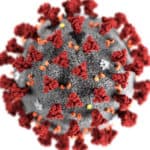To vaccinate or not to vaccinate? That is not the question!
 This is a guest post by CAFP Member Megan Lykke, MD, in Fruita, CO.
This is a guest post by CAFP Member Megan Lykke, MD, in Fruita, CO.
I admit; I was nervous. I received my first COVID vaccine in December. This means I was in the first group of people across the country. I knew I would get the vaccine. Spending a year as a health care worker in a pandemic was stressful. I had been fortunate to never to go work afraid for myself and my family before that year, and this was the first possibility at a way out of the pandemic, yet I was not sure I wanted the vaccine so early. I thought I could rely on others to get it first. Yet the opportunity was there, and I put on my brave face and did it. I also had reasons for my decision. It was not my emotions or nervousness that fueled my decision. Nor was it politics, or the news, or social media. My decision was driven by logic. It was logic because I realized something. The questions is not: “Do I get vaccinated or not?” the question is: “Do I want to get vaccinated, or do I want to get COVID?”
The problem is this: COVID is not an epidemic. An epidemic is someone else’s problem, it happens to other people in another place, not to me. It goes away without getting to my area of the world. I hear about it in the news, but it does not change my daily life. No, COVID is not an epidemic, it is a pandemic. A pandemic affects everyone. Every single person in the entire world. This means it’s not going to just go away. This means that even little me, in my small corner of the world, is just not going to be able to avoid it. It is here, now, today, and it will not disappear.
In the many thousands of years of the history of human beings, there have always been pandemics, and there are only two ways to end a pandemic. One is to control the vector. The vector is the thing that passes the virus around. My ancestor, George Sternberg MD, helped discover that mosquitoes were the vector for his epidemic, yellow fever. Now today, thanks to mosquito control programs across the county, we are fortunate to not have large outbreaks of yellow fever, or malaria, as my ancestors did. But the vector in COVID is human beings, not mosquitos. We have tried to control the vector with social distancing, but we all know that this is not a long term sustainable idea. Human beings are social beings, and to distance forever means death. We can’t of course kill the vector, so we have to move to the only other way to control a pandemic- herd immunity.
The “herd” comes from a herd of cattle, and it means that the large majority of the vector has to be immune for the virus to stop being passed around and to “disappear.” It does not really disappear, but it is around at very very low levels. I was taught in medical school that we caused small pox to “disappear” because of the vaccine, yet there are still a few cases out there in the world- so it really has not disappeared, it is just around in very low levels. COVID will be the same.
It is here, it will not disappear. The number to get to herd immunity is different for every disease. COVID is new, and has not been around long enough for us to know what number is needed for herd immunity, however, COVID is highly infectious. This means it is passed around very easily. We know the numbers for things that are highly infectious to get to herd immunity are very high. One example is measles, this was a highly infectious pandemic of the past, and the number needed for herd immunity was 93 percent.
93 percent, even I, the doctor and scientist, find that number astonishing. While we do not know if this is the number for COVID, it seems likely that it will be something similar. This would mean that 93 percent of people have to get all the variants of COVID (not just one) or get vaccinated. This is not 93 percent of my county, or my country, but 93 percent of the entire world. To think that I, one small human, could confront a number like 93 percent and come out in the lucky 7% that remains unaffected; well, that is just wishful thinking. It is not going to happen.
There are several other things people need to know about the science behind herd immunity to understand the breadth of the situation. The first is that we need high numbers to reach herd immunity because nothing in this world is 100 percent. The vaccines are highly effective; many are over 90 percent effective. Yet that still means for 10 percent of people they are not effective. Every single vaccine has some percentage of people that their particular immune system does not make the right proteins to respond to the vaccine, and despite being vaccinated, they are still not immune. This is where the concept of herd immunity becomes a concept of community. The entire world is a community that has to fight this together, as one.
This breaks every social, geopolitical, and racial boundary. We are all in this together, and it will take every person in the world to fight it. The longer people wait to get vaccinated, the longer the pandemic will continue. By everyone being vaccinated, we are protecting those whose bodies cannot mount an immune response. This explains why people that are vaccinated can still get COVID, and until we reach herd immunity, they will still get COVID, COVID will still propagate, and it will have the time and place to keep developing new strains. By remaining unvaccinated, you are harming those in society that do not have the same immune system as yourself.
At this point, we have given the vaccine to millions of people around the world. It is safe, and it is effective. If you had COVID, you should still get the vaccine, because it will protect you and others from the other strains out there. Herd immunity is only possible with community. I know not everyone will make their own decisions by logic, but if I can help 1% or even 5% more of you to be comfortable with that decision, that is 1% or 5% step closer to ending the pandemic.
